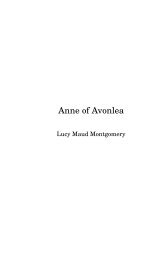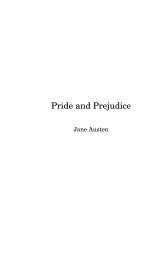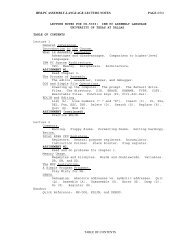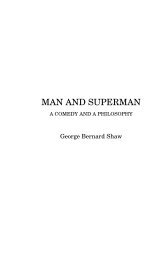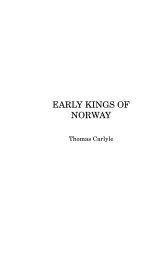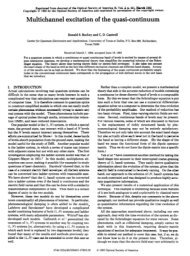PSAC - Sandroid.org
PSAC - Sandroid.org
PSAC - Sandroid.org
You also want an ePaper? Increase the reach of your titles
YUMPU automatically turns print PDFs into web optimized ePapers that Google loves.
The Birds ProjectThe newlib-1.9.0 Library, Plan forSoftware Aspects ofCertificationRonald S. Burkey, et al.Version 0.0102/24/02Copyright © 2002 by Ronald S. Burkey and Red Hat, Inc.Licensing information: Permission is granted to make and distribute verbatim copiesof this documentation, provided the copyright notice and this permission notice arepreserved on all copies. Permission is granted to copy and distribute modifiedversions of this documentation under the conditions for verbatim copying, providedalso that the entire resulting derived work is distributed under the terms of apermission notice identical to this one. Permission is granted to copy and distributetranslations of this documentation into another language, under the above conditionsfor modified versions.
1. Purpose of the <strong>PSAC</strong> DocumentThis is a standard "Plan for Software Aspects of Certification" document,corresponding to the guidelines in RTCA DO-178B. It describes the generalcharacteristics of the system and its software, certification considerations, life cyclesand life-cycle data, and scheduling of the software-development effort.2. System Overview2.1. Overview of the SystemThe newlib-1.9.0 library is intended to be a C-language library of code which has beenpre-certified under DO-178B, and which is therefore available for use as "previouslywritten software" in building airborne-software applications. It corresponds to a subsetof the standard C function library.In other words, newlib-1.9.0 is not a complete system, but can be used as a softwarecomponent of an airborne system without further development or certification effort,except (for example) obtaining the signoff of a DER. Note that obtaining the signoff ofa DER who has previously approved newlib-1.9.0 is likely to be most efficient means ofdoing so.The newlib-1.9.0 library software is available for free use by anyone, under the termsterms set out in the file called "COPYING.NEWLIB" provided with the source code.Briefly, a developer may link his software to newlib, free of charge, and no particularlicensing modifications need to be made to his own software. However, certaincopyright notices may need to be displayed. COPYING.NEWLIB is reproduced in itsentirety at the end of the <strong>PSAC</strong>.Significant portions of the certification documentation have been taken directly from(or slightly adapted from) GNUpro documentation provided by Red Hat, Inc., and forthis reason the certification documentation is licensed under terms specified by RedHat, namely: Permission is granted to make and distribute verbatim copies of thisdocumentation, provided the copyright notice and this permission notice are preservedon all copies. Permission is granted to copy and distribute modified versions of thisdocumentation under the conditions for verbatim copying, provided also that the entireresulting derived work is distributed under the terms of a permission notice identical tothis one. Permission is granted to copy and distribute translations of this documentationinto another language, under the above conditions for modified versions.1
The newlib-1.9.0 Library, <strong>PSAC</strong>The newlib-1.9.0 library is commercial off-the-shelf software (COTS) that was notexplicitly written for airborne applications, and therefore is not certifiable per se asobtained directly from its distributer, Red Hat, Inc. The present development effort isan attempt to provide satisfactory documentation and software verification for aspecific version of the newlib library, namely version 1.9.0.Other embeddable C libraries could have been chosen for this project in place of RedHat newlib. The choice of newlib for this project reflects the following philosophicalcriteria:1) To supply a minimal C-callable API appropriate for writing simple embeddedairborne applications. The API should include things such as file-system functions,string manipulation functions, timekeeping functions, and so forth.2) To retain maximal portability from CPU type to CPU type, with a minimum portingeffort.3) To use mature software that has been deployed in thousands of prior (thoughnon-airborne) projects, and hence for which the rate of development and new-bugdiscovery has reached low levels.2.2. System Functions2.2.1. Standard Utility Functions2.2.1.1. DescriptionThis is a subset of the functionality (familiar to C-language programmers) representedby the stdlib.h header file.2.2.1.2. Hardware-Software AllocationThis functionality is provided entirely in software.2.2.2. Character Type Macros2.2.2.1. DescriptionThis is a subset of the functionality (familiar to C-language programmers) represented2
The newlib-1.9.0 Library, <strong>PSAC</strong>by the ctype.h header file.2.2.3. Input and Output2.2.3.1. DescriptionThis is a subset of the functionality (familiar to C-language programmers) representedby the stdio.h header file.2.2.4. Strings and Memory2.2.4.1. DescriptionThis is a subset of the functionality (familiar to C-language programmers) representedby the string.h header file.2.2.5. Signal Handling2.2.5.1. DescriptionThis is a subset of the functionality (familiar to C-language programmers) representedby the signal.h header file.2.2.6. Time Functions2.2.6.1. DescriptionThis is a subset of the functionality (familiar to C-language programmers) representedby the time.h header file.3
2.2.7. LocaleThe newlib-1.9.0 Library, <strong>PSAC</strong>2.2.7.1. DescriptionThis is a subset of the functionality (familiar to C-language programmers) representedby the locale.h header file.2.2.8. Reentrancy2.2.8.1. DescriptionThe library functions ensure that, whenever possible, there is reentrancy. However,there are some functions that can not be trivially made reentrant. Hooks have beenprovided to allow these functions to be used in a fully reentrant fashion. These hooksuse the structure, _reent, defined in reent.h.All functions which must manipulate global information are available in two versions.The first version has the usual name, using a single global instance of the reentrancystructure.The second has a different name, normally formed by prepending _ and appending _rand taking a pointer to the particular reentrancy structure to use.2.2.9. System Calls2.2.9.1. DescriptionIn case the operating system (if any) provides functionality not directly provided bynewlib-1.9.0, the library provides means of making a system call to the operatingsystem.2.2.10. Variable Argument Lists2.2.10.1. DescriptionThis is a subset of the functionality (familiar to C-language programmers) represented4
The newlib-1.9.0 Library, <strong>PSAC</strong>by the stdarg.h and varargs.h header files.2.2.11. Miscellaneous Macros and Function Calls2.2.11.1. DescriptionAdditional functionality not present in the standard C library may also be provided.2.3. System ArchitectureBecause the newlib-1.9.0 library is intended to be as portable as possible, it requires nospecific system architecture.For example, no specific requirements on the quantity or address range of RAM ismade.Furthermore, the newlib-1.9.0 library has no specific dependence upon, or knowledgeof, specific hardware peripherals that may or may not be present within the system. Alllow-level access to such functionality occurs through driver functions provided outsideof newlib-1.9.0 itself.2.4. ProcessorsThe newlib-1.9.0 library as distributed by Red Hat, Inc., supports a wide variety ofCPU types and operating systems. However, the initial airborne certification effort fornewlib-1.9.0 supports only the following CPU/operating-system combinations:Intel ’x86 CPU family without operating system.PowerPC without operating system.Motorola Coldfire without operating system.Motorola Coldfire with RTEMS operating system.Hopefully, later versions of newlib-1.9.0 will contain other CPU/operating-systemcombinations.By "without operating system", we mean that use of those functions in the newlib-1.9.0library dependent on the presence of an operating system is disallowed. There may still5
The newlib-1.9.0 Library, <strong>PSAC</strong>be an operating system of some kind present, but newlib-1.9.0 interaction with it is notsupported.2.5. Hardware-Software InterfacesAs may be deduced from the descriptions of the hardware-software allocations in the’System Overview’ section, newlib-1.9.0 as such has no dependence on or knowledgeof the hardware.Instead, there is a hardware-abstraction layer (HAL), whose functions are defined in thenewlib-1.9.0 design data, but which are actually provided by separately (if used). Theseare separate from newlib-1.9.0, and have life cycles separate from newlib-1.9.0.2.6. Safety FeaturesBecause newlib-1.9.0 is a reusable library rather than a complete system, it does notattempt to provide safety features as such.3. Software Overview3.1. Resource SharingAll functions in the newlib-1.9.0 are reentrant (except as specified in their specificdescriptions, in which case reentrant alternatives are generally provided), and hence aresuitable for use in conjunction with multi-tasking operating systems such as RTEMS.Since newlib-1.9.0 is a general-purpose, portable, reusable library, no specificstatements can be made about its memory requirements or CPU time requirements.3.2. RedundancyNot relevant, since newlib-1.9.0 is a reusable library rather than a complete system.6
3.3. Multiple-Version Dissimilar SoftwareNot used by newlib-1.9.0.The newlib-1.9.0 Library, <strong>PSAC</strong>3.4. Fault-Tolerance, Failure Detection, and SafetyMonitoringNot provided by the newlib-1.9.0 library.3.5. Software Timing and Scheduling StrategiesSince newlib-1.9.0 is a general-purpose portable library without knowledge ofunderlying hardware, it does not in itself impose any requirements on software timingnor scheduling. However, certain newlib-1.9.0 functionality does indirectly relate totiming requirements. For example, the time function, which returns the current time,depends indirectly on the existence of a hardware real-time clock or the existence of anaccurate software timer (presumably implemented via an interrupt-service routine).However, this relationship between newlib-1.9.0 and the actual timing mechanism ismediated by the Hardware Abstraction Layer not present within newlib-1.9.0 itself(i.e., which must be provided separately from newlib-1.9.0). Therefore, no specificrequirements or other statements regarding software timing can be made.4. Certification Considerations4.1. Software Level and Means of ComplianceThe software is suitable for certification via RTCA DO-178B at level C.4.2. Justification of Software LevelSince newlib-1.9.0 is a reusable library, rather than a complete system, it requires nosafety justification as such.7
4.3. Potential Software Contributions to FailureConditionsThe newlib-1.9.0 Library, <strong>PSAC</strong>Because the conditions of use of newlib-1.9.0 cannot be known (it may be used indeveloping software for any software of level C, D, or E), there is no way to know hownewlib-1.9.0 may potentially contribute to failure conditions. There is no justificationfor using newlib-1.9.0 in developing software at levels A or B with the presentcertification materials.5. Software-Component Life CyclesFor this project, there is only one software component, namely the newlib-1.9.0 library,and hence only one life cycle.5.1. Life Cycle of newlib-1.9.0 Library Development5.1.1. Life-CycleBecause the newlib-1.9.0 development effort described here represents the creation ofcertification materials for pre-existing COTS software, the development processes andtheir ordering are somewhat out of the ordinary.From the standpoint of the present development effort, the life cycle of the newlib-1.9.0library began with the Coding Process. Explanation: While equivalents to PlanningProcesses, Requirements Processes, or Design Processes may have been undertaken bythe various individuals and <strong>org</strong>anizatons which have provided the actual software, thereis no accessible, satisfactory documentation for such processes. Consequently, for thepurposes of this project, it must be assumed that these additional processes did notactually occur. Similarly considerations apply to Software Verification Processes.So, to reiterate: The life cycle of the newlib-1.9.0 library begins with the CodingProcess. The Coding Process is followed by the Planning Process. The PlanningProcess, in turn, is followed by three separate chains of development processes thatoccur roughly simultaneously. One chain consists just of the SCM Process. Anotherchain consists just of the SQA Process. The third chain consists of the RequirementsProcess, Design Process, and Software Verification Process. For brevity, the latter willbe referred to hereafter as the "RDIV chain".8
The newlib-1.9.0 Library, <strong>PSAC</strong>Because we are merely attempting to certify pre-developed software, some of thedevelopment processes are rather abbreviated. For example, the SCM process needsmerely to archive the newlib-1.9.0 library (not to provide for further development of it)and to manage the life-cycle data. The Planning, Requirements, and Design processesneed merely to document work which has already been done. There is no IntegrationProcess as such, because (newlib-1.9.0 being a reusable, hardware-independent library)there’s nothing to integrate. On the other hand, the Software Verification Process is asextensive as for any other development effort.Upon completion of the development effort, which is the release of the software by theSQA Process, life cycle data is available for input to a Certification Liaison Process.However, the Certification Liaison Process is really outside of the scope of thenewlib-1.9.0 development effort, since the software produced is merely a reusablelibrary and not a complete system.Although not possible for the first newlib-1.9.0 release, due to non-availability ofpersonnel, it is hoped that subsequent releases can be reviewed by DER as part of thedevelopment effort, allowing very rapid signoff of form 8110 for developers using thenewlib-1.9.0 library. If this capability becomes available, it will form part of theCertification Liaison Process.9
The newlib-1.9.0 Library, <strong>PSAC</strong>Figure 1. Life Cycle SummaryCodingProcessPlanningProcessRequirementsProcessDesignProcessIntegrationProcessSoftwareConfigurationManagementProcessSoftwareQualityAssuranceProcessSoftwareVerificationProcessCertificationLiaisonProcess5.1.1.1. Life-Cycle Processes5.1.1.1.1. Planning ProcessThe Planning Process precedes all other life-cycle processes, except the CodingProcess. (The Coding Process is first, since the newlib-1.9.0 development effort merelyattempts to certify pre-written COTS software.) The Planning Process produces oridentifies all other Plans or Standards guiding the remainder of thesoftware-development effort. The specific aim of the newlib-1.9.0 Planning Process isto address all of the issues outlined in DO-178B section 4.0.10
5.1.1.1.1.1. Transition Criteria and Satisfaction of ObjectivesThe newlib-1.9.0 Library, <strong>PSAC</strong>The Planning Process is followed by three separate chains of life-cycle processes, withthe three development chains running simultaneously in parallel. These chains are theSCM Process, the SQA Process, and the RDIV chain (see the ’Life-Cycle’ section).The transitions from the Planning Process to these development chains do notnecessarily occur simultaneously.The Planning Process transitions to the RDIV chain when the <strong>PSAC</strong>, SDP, SVP, SECI,SRS, SDS, and SCS documents have all been successful reviewed and signed off.Subsequent changes to these documents may require a return from the Design Processor Software Verification Process to the Requirements Process, but the Planning Processis never re-entered in any given life cycle.The Planning Process transitions to the SCM Process upon successful review andsignoff of the SCMP.The Planning Process transitions to the SQA Process upon successful review andsignoff of the SQAP.5.1.1.1.2. Requirements ProcessThe purpose of the Requirements Process is to elucidate the existing newlib-1.9.0software as an easy-to-grasp set of the high-level software requirements. In the case ofnewlib-1.9.0, this is essentially a listing of the various groups of C-language functionsprovided by the library. However, the intention of the newlib-1.9.0 RequirementsProcess is to address all of the issues outlined in DO-178B section 5.1.The Requirements Process also addresses all considerations of DO-178B section 6.3.1,which according to DO-178B may form a part of the Software Verification Process.This can be done because at the proposed software level (’C’), there is no requirementof independence.5.1.1.1.2.1. Transition Criteria and Satisfaction of ObjectivesThe Requirements Process transitions to the Design Process upon successful reviewand signoff of the SRD.11
5.1.1.1.3. Design ProcessThe newlib-1.9.0 Library, <strong>PSAC</strong>Since the newlib-1.9.0 software is pre-existing, the main purpose of the Design Processis to detail the API definition of the various C-language functions provided by thelibrary. However, all of the issues outlined in DO-178B section 5.2 are addressed.The Requirements Process also addresses all considerations of DO-178B sections 6.3.2& 6.3.3, which according to DO-178B may form a part of the Software VerificationProcess. This can be done because at the proposed software level (’C’), there is norequirement of independence.5.1.1.1.3.1. Transition Criteria and Satisfaction of ObjectivesThe Design Process transitions to the Integration Process upon successful review andsignoff of the SDD.5.1.1.1.4. Coding ProcessSince this development effort is an attempt to certify pre-existing software, there is notreally a Coding Process as such. Or, more accurately, there was a Coding Processrequiring a number of years to complete, but the details of this process are inaccessibleto the current development effort. The current development effort, as a philosophicaldecision, will not modify any newlib runtime source code.Test code not present in the Red Hat newlib v1.9.0 release, on the other hand, may beprovided by this project.5.1.1.1.4.1. Transition Criteria and Satisfaction of ObjectivesThe completion of the Coding Process in this development effort is a given. Realdevelopment effort begins with an essentially automatic transition to the PlanningProcess.5.1.1.1.5. Integration ProcessThe purpose of the Integration Process is to integrate the software with the targethardware. Since the aim of the newlib-1.9.0 project is to produce a highly portablelibrary, rather than a hardware-specific library or a physical device, there really can beno required Integration Process.12
The newlib-1.9.0 Library, <strong>PSAC</strong>For any given target architecture, the general-purpose newlib-1.9.0 library is combinedwith a specific Hardware Abstraction Layer functions specific to that target. It is in theIntegration Process of the hardware-abstraction layer life cycle or the application codelife cycle (both of which are independent of newlib-1.9.0) that the integration occurs.5.1.1.1.5.1. Transition Criteria and Satisfaction of ObjectivesThe Integration Process proceeds directly to the Software Verification Process withoutany effort whatever.5.1.1.1.6. Software Verification ProcessIn the words of DO-178B section 6.1, "The purpose of the software verification processis to detect and report errors that may have been introduced during the softwaredevelopment processes." The newlib-1.9.0 Software Verification Process attempts toaddress all of the issues outlined in DO-178B chapter 6, except the following:1) The Requirements Process addresses all considerations of DO-178B section 6.3.1.This can be done because at the proposed software level (’C’), there is no requirementof independence.2) The Design Process addresses all considerations of DO-178B sections 6.3.2 & 6.3.3.This can be done because at the proposed software level (’C’), there is no requirementof independence.3) Reviews and analysis of the outputs of the Integration Process (DO-178B section6.3.5) are not addressed here (or elsewhere) since the entire Integration Process isoptional. Refer to the ’Integration Process’ section of the <strong>PSAC</strong> for further explanation.5.1.1.1.6.1. Transition Criteria and Satisfaction of ObjectivesThe Software Verification Process has several outputs:a) Review and analysis of the source code.b) The SVCP.c) Review and analysis of the test results.d) The software-test results themselves.The Software Verification Process can transition to various other life cycle processes:1) To the SQA Process upon successfully creating all Software Verfication Processoutputs.13
2) To the Coding Process upon detection of errors in software testing.The newlib-1.9.0 Library, <strong>PSAC</strong>3) To the Requirements Process or Design Process upon detection of errors moreappropriately resolved in the SRD or SDD than in the code.5.1.1.1.7. Software Configuration Management ProcessThe Software Configuration Management Process (or just ’SCM Process’) for the mostpart operates simultaneously with the other life cycle processes. DO-178B chapter 7sets out the objectives and activities of the SCM Process in some detail. In summary,the SCM Process provices the following activities:1) Identifying configurations.2) Implementing change control.3) Establishing baselines.4) Archiving the software and the life cycle data.Though for graphical reasons the figure at the top of the ’Life-Cycle’ section of thisdocument depicts the SCM Process as spanning merely the Requirements, Design, andCoding Processes, it actually spans all other life cycle processes, and beyond. Oncedata is archived by means of the SCM Process, it is theoretically intended to remainarchived as long as the newlib-1.9.0 software is present within any airborne units.Of course, since the Birds Project is not a manufacturer of airborne equipment, and thenewlib-1.9.0 library is intended to be used by manufacturers of such equipment, it isnot really within the capability of the Birds Project to guarantee this essentiallyindefinite data retention. It is therefore assumed that users of the newlib-1.9.0 libraryhave prudently archived the version of newlib-1.9.0 they are using -- i.e., all code andlife-cycle data -- within the SCM Processes of their own development efforts.5.1.1.1.7.1. Transition Criteria and Satisfaction of ObjectivesThe SCM Process does not transition to other life cycle processes, since it operates inparallel with such other processes.Ultimately, the SCM Process exists to archive life cycle data, and to perpetuallymaintain this archive subject to the limitations described above. The outputs of theSCM Process are the SCI and the SCM Records demonstrating archival activity. TheSECI, which may legitimately be viewed as an output of the SCM Process, is actuallyproduced by the Planning Process, but may subsequently be altered by the SCMProcess.14
The newlib-1.9.0 Library, <strong>PSAC</strong>The newlib-1.9.0 SCM Process is slightly simplified over that of a more usual airbornedevelopment effort, in that the software itself is pre-existing and is not modified withinthis development effort. Consequently, the only effort really required to archive andcontrol the software itself, is to save a permanent copy of the software as received fromits distributer, Red Hat, Inc.5.1.1.1.8. Software Quality Assurance ProcessThe objectives and activities of the Software Quality Assurance Process (or just ’SQAProcess’) are set out in chapter 8 of DO-178B. Basically, the SQA Process examinesthe outputs of the other life cycle processes and determines their internal consistency.In other words, it acts to assure that what has actually been accomplished is what wasrequired to be accomplished.Among the important activities of the SQA Process are these:1) Establishement and management of the problem-reporting system.2) Final release of the software.The SQA Process operates simultaneously with the other life cycle processes, andspans the Planning Process through release of the software.The SQA Process, at the proposed software level (’C’), is the only development processhaving any requirement of independence. In other words, in a usual development effortat Level C, one would expect to find the SQA function performed by independentpersonnel from those of the other life cycle processes.However, the newlib-1.9.0 provides an interesting distinction from more-usualdevelopment efforts, in that the software being certified is pre-written and not modifiedby this development effort. Furthermore, while the Requirements Process and DesignProcesses do provide documentation, this documentation is not of requirements anddesign data produced by this development effort, but is merely a corrected form ofpre-written (but non-certification) documentation created independently.In other words, the SQA function is inherently highly independent from all actualplanning, all actual design, and all actual coding. In light of this, there seems to belittle reason to have a separate person (within the present development effort) performthe SQA functions than perform the other life-cycle processes. The newlib-1.9.0development effort can operate as a single-individual project without compromisingindependence of the SQA Process in any significant way.15
5.1.1.1.8.1. Transition Criteria and Satisfaction of ObjectivesThe newlib-1.9.0 Library, <strong>PSAC</strong>The SQA Process transitions to the Certification Liaison Process upon release of thesoftware. The outputs of the SQA Process are the SQA Records.The primary output of the SQA Process is the Software Conformity Review, which isthe last step in the release of the software. The Software Conformity Review, however,takes into account not only the life cycle data in general, but also various other SQARecords.5.1.1.1.9. Certification LiaisonSince the product of the newlib-1.9.0 development effort is a reusable library ratherthan an actual airborne device, there are really no certification efforts associated with it,and thus no real Certification Liaison Process.However, since the intention of the newlib-1.9.0 project is to not merely providesoftware but to make it very conveniently usable by developers, a very usefulcertification activity would be review and approval by a DER. This "pre-approval" by aDER would allow immediate signoff of 8110 forms for developers using thenewlib-1.9.0 library, very simply and relatively cheaply.It is not known as this is written whether such DER activity will actually occur. Hence,it should be regarded as an optional activity that may be omitted.5.1.1.1.9.1. Transition Criteria and Satisfaction of ObjectivesThe outputs of the Certification Liaison Process can be these:1) Informal notification that a DER finds the life cycle data acceptable and will beavailable to sign off (via 8110) upon demand, for a known fee.2) Notification of life-cycle data problems that will require repair before the DER findsthe data acceptable.Upon the former (option #1), the Certification Liaison Process ends, but there are nofurther processes to which a transition can occur. Of course, the availability of signoffwould be published, so that newlib-1.9.0 users could be made aware of it.Upon the latter (option #2), problem reports are filed concerning the problems whichhave been found. Also, a transition may (or may not) occur to an earlier life cycleprocess so that the problems can be fixed. The reason for this uncertainty of action isthat while approval by the DER is a desirable result of the development effort, it is not a16
The newlib-1.9.0 Library, <strong>PSAC</strong>crucially necessary one from the point of view of the Birds Project. These findings areoften a matter of opinion, and a different DER might view the life cycle data differently.5.1.1.2. OrganizationThe Birds Project differs from most <strong>org</strong>anizations involved in airborne softwaredevelopment, in the sense that it is not a commercial <strong>org</strong>anization engaged inmanufacturing a product. Instead, it is an effort to freely provide certification-friendlymaterials to the aviation community, as a service. Furthermore, at least at the time ofinception of the newlib-1.9.0 development effort, it is not really "<strong>org</strong>anized" at all and,indeed, consists of a single individual.In contrast, the pre-written software which this development effort is attempting tocertify, and the pre-written documentation which has been absorbed and corrected inthis project’s documentation, have been written by a large and unknown assemblage ofindividuals, over a period of many years. These individuals have often not beenassociated with any clearly definable <strong>org</strong>anization. In particular, even though thepre-written newlib library, version 1.9.0, is a "product" of Red Hat, Inc., it was notwritten by Red Hat, Inc., and very few of the individuals involved are likely to beassociated with Red Hat, Inc.For these reasons, the <strong>org</strong>anization of the newlib-1.9.0 development effort cannot beunderstood in terms of an "<strong>org</strong> chart" with a neatly defined flow of authority. One mustinstead concentrate only on the individuals involved, and even then only on theindividuals involved in the certification effort as opposed to the development of theactual software.5.1.1.3. Organizational ResponsibilitiesAs explained earlier, because pre-written software is being certified, it is possible forthe newlib-1.9.0 development effort to operate with a single individual, and still tomaintain the "independence" requirements (see DO-178B Table A-9) at the proposedsoftware level (’C’).For the initial release of newlib-1.9.0, this minimum (1 person) is used. For laterreleases, more or other personnel may be used. In this section, all personnel involved inall releases are identified, and their levels of involvement in these releases are madeclear. Because there is no corporate entity providing authority for the developmentactivities, we also provide brief resumes of participating individuals, so that theirqualifications for their activities are clear.17
Personnel for newlib-1.9.0 version 1.00The newlib-1.9.0 Library, <strong>PSAC</strong>Ronald S. Burkey has a B.S. degree in Mathematics and a Ph.D. in Physics. He hasbeen professionally involved in designing electronic hardware and firmware forairborne applications (and non-airborne applications) since 1984. He has beenresponsible for both DO-178A and DO-178B certification efforts.5.1.1.4. Certification LiaisonBecause newlib-1.9.0 is a reusable library rather than a complete airborne product, nodirect interaction with certification authorities is required.5.1.2. Life-Cycle Data5.1.2.1. Data ItemsBecause newlib-1.9.0 is a reusable library rather than a complete airborne product, nooccasion for submission of life cycle data by the Birds Project arises. Rather, all of thelife cycle data items described below are made available to developers wishing to usethe newlib-1.9.0 library, or to anyone else, along with newlib-1.9.0 source code. Thestatus of this data within the development efforts of newlib-1.9.0 users cannot inprinciple be known to the newlib-1.9.0 development effort, and hence cannot bespecified here.The following items or categories of life cycle data items are created.The Plan for Software Aspects of Certification (<strong>PSAC</strong>) is created by the PlanningProcess.The Software Development Plan (SDP) is created by the Planning Process.The Software Verification Plan (SVP) is created by the Planning Process.The Software Configuration Management Plan (SCMP) is created by the PlanningProcess.The Software Quality Assurance Plan (SQAP) is created by the Planning Process.The Software Requirements Standards (SRS) are created by the Planning Process.The Software Design Standards (SDS) are created by the Planning Process.The Software Code Standards (SCS) are created by the Planning Process.The Software Requirements Data (SRD) are created by the Requirements Process.18
The newlib-1.9.0 Library, <strong>PSAC</strong>The Software Design Description (SDD) is created by the Design Process.The Source Code is created by the Coding Process.There is no Executable Object Code in general, since newlib-1.9.0 is a reusable libraryrather than a complete product. Creation of Executable Object Code is performed byintegrating newlib-1.9.0 with a target-specific Hardware Abstraction Layer, which ispresently visualized as a separate activity from newlib-1.9.0 development itself. Forspecific CPU/operating-system types that have been specified as "supported",Executable Object Code in the form of linkable libraries is provided.The Software Verification Cases and Procedures (SVCP) and Software VerificationResults (SVR) are created or completed by the Software Verification Process.The Software Life Cycle Environment Configuration Index (SECI) is created by thePlanning Process, but may be altered by the SCM Process prior to creation of theExecutable Object Code (if any) or transition to the Software Verification Process.The Software Configuration Index (SCI) is produced by the SCM Process.Problem Reports are sanctioned and maintained by the SQA Process, but may actuallybe produced at any time, by anyone with access to the newlib-1.9.0 problem-reportingsystem.SCM Records are produced by the SCM Process.SQA Records are produced by the SQA Process.The Software Accomplishment Summary (SAS) is produced by the SQA Process.5.1.2.2. Data RelationshipsAll relationships among life cycle data items seem clear from the ’Life-Cycle’ sectionabove.5.1.2.3. Data FormatsAll data items other than Source Code and Executable Object Code are made availableas Adobe PDF files, viewable with the freely available Adobe Acrobat Reader program.This includes the SVR, and all SCM Records and SQA Records (such as review andaudit forms). If necessary, hand-written data is scanned in order to produce thenecessary PDF files.Source Code is made available as a UNIX ’tar’ file, known as a "tarball", compressedwith the ’gzip’ utility. Separate tarballs are provided for the Red Hat supplied source19
distribution and for the test code created by this project.The newlib-1.9.0 Library, <strong>PSAC</strong>Executable Object Code (actually, linkable libraries) for the specific CPU types used inthe Software Verification Process are provided as UNIX-type ’ar’ libraries.Finally, to assure that complete file-sets for releases are available, all of the filesmentioned above are combined with UNIX tar into a single tarball.In summary, all life cycle data items are available in an on-line downloadable formatrather than as hardcopies.5.1.2.4. Means of Submitting Life-Cycle DataSince newlib-1.9.0 is a reusable library rather than a complete product, no directsubmittal of data by the Birds Project is envisaged. However, all life cycle data (codeand documentation) are available to software developers, certification authorities, orany other parties, via download over the Internet.In practice, it is envisaged that developers wishing to use newlib-1.9.0 for their projectswill download the source code and other life cycle data, will archive them within theirown SCM Processes, and will perform whatever submissions are required.6. ScheduleBecause newlib-1.9.0 is a library reusable by developers of airborne software, ratherthan for use in any specific standalone hardware-based device, there is no obviousreason for any scheduled interactions with certification authorities.The newlib-1.9.0 library is not a commercial project with a planned release date orother milestones. Hence it can be released whenever it happens to be ready.In summary, there is no relevant scheduling data that can be presented for the initialdevelopment effort.20
7. Additional ConsiderationsThe newlib-1.9.0 Library, <strong>PSAC</strong>7.1. Alternate Methods of ComplianceNo qualification means alternate to DO-178B are used.7.2. Tool QualificationIn general, a tool requires qualification if its output is used without examination. If theoutput of the tool is itself verified (by review, testing, or analysis) this constitutes animplicit qualification of the tool itself. With that in mind, we can examine the toolsused, one-by-one, and determine their need for qualification:Native compiler, linker, library archiver, and low-level libraries (gcc, ld, ar, andlibgcc.a). These are used for creating desktop-computer executable code for testingpurposes, or for creating embedded code if the target processor just happens to be thesame as that of a common desktop computer (like Intel ’x86 or PowerPC). These toolsdo not require qualifiation, since their outputs (the executable code) are tested.Cross-compiler, linker, library archiver, and low-level libraries (gcc, ld, ar, andlibgcc.a). These are used for creating embedded Executable Object Code from adesktop computer, but for a different target CPU type. Technically, these tools also donot need qualification, since newlib-1.9.0 does not produce Executable Object Code forthese environments as part of its life cycle data. Rather, separate Hardware AbstractionLayer (HAL) development efforts create this Executable Object Code. As a practicalmatter, however, the Birds Project wants the newlib-1.9.0 library to be as easily usableby developers as possible, and this means that this issue cannot be side-stepped. EasingHAL qualification is handled by crafting the test suites so that they can be executed ineither the desktop environment or in the target environment (albeit with perhaps moreeffort).Coverage tool (gcov). This is a tool which provides a survey of all source-code lines,indicating which of them have been exercised in testing and which have not. Thecoverage tool must be qualified, since there is no direct way of verifying its output. Thequalification shall be done by creating a C-language program in which various bits ofcode are known to execute or not execute, and then to test it with gcov.All other tools used either have outputs which are examined, or which feed intooperations whose outputs are examined. Therefore, no other tools require qualification.21
7.3. Previously-Developed SoftwareAdditonal previously-developed software is not used by newlib-1.9.0.The newlib-1.9.0 Library, <strong>PSAC</strong>7.4. Option-Selectable SoftwareThe newlib-1.9.0 library is not, and does not contain, option-selectable software.7.5. User-Modifiable SoftwareThe newlib-1.9.0 library is not, and does not contain, user-modifiable software.7.6. Commercial Off-the-Shelf SoftwareThe newlib-1.9.0 library does not use any additional COTS.7.7. Field-Loadable SoftwareThe newlib-1.9.0 library is not field-loadable as such, but could conceivably be used bya developer producing a field-loadable program. If so, any considerations relating tothis will be outlined in that developer’s life cycle data.7.8. Multiple-Version Dissimilar SoftwareThe newlib-1.9.0 library does not use multiple-version dissimilar software.7.9. Product Service-HistoryNot applicable.22
8. COPYING.NEWLIBThe newlib-1.9.0 Library, <strong>PSAC</strong>Because the source code for newlib-1.9.0 was written by a large assemblage ofdevelopers, over a period of many years, various developers have chosen to placevarious licensing restrictions on the portions of code which they personally provided. Ingeneral, these provisions are very mild, and should not prevent anyone wanting to usethe code from doing so, though display of certain copyright notices may be required.Red Hat, Inc., has distilled these licensing requirements into a single document,COPYING.NEWLIB, provided with the newlib-1.9.0 source code. This document isreproduced in its entirety here, shown in a fixed-width font for emphasis:The newlib subdirectory is a collection of software from severalsources. Each have their own copyrights embedded in eachfile that they concern.(1) University of California, BerkeleyCopyright (c) 1990 The Regents of the University of California.All rights reserved.Redistribution and use in source and binary forms are permittedprovided that the above copyright notice and this paragraph areduplicated in all such forms and that any documentation,advertising materials, and other materials related to suchdistribution and use acknowledge that the software was developedby the University of California, Berkeley. The name of theUniversity may not be used to endorse or promote products derivedfrom this software without specific prior written permission.THIS SOFTWARE IS PROVIDED “AS IS” AND WITHOUT ANYEXPRESS OR IMPLIED WARRANTIES, INCLUDING, WITHOUTLIMITATION, THE IMPLIED WARRANTIES OF MERCHANTABILITYAND FITNESS FOR A PARTICULAR PURPOSE.(2) DJ DelorieCopyright (C) 1991 DJ Delorie, 24 Kirsten Ave,Rochester NH 03867-2954This file is distributed under the terms listed in the document"copying.dj", available from DJ Delorie at the address above.A copy of "copying.dj" should accompany this file; if not, a copyshould be available from where this file was obtained. This filemay not be distributed without a verbatim copy of "copying.dj".23
The newlib-1.9.0 Library, <strong>PSAC</strong>This file is distributed WITHOUT ANY WARRANTY; without eventhe implied warranty of MERCHANTABILITY or FITNESS FOR APARTICULAR PURPOSE.(3) David M. Gay at ATThe author of this software is David M. Gay.Copyright (c) 1991 by ATPermission to use, copy, modify, and distribute this softwarefor any purpose without fee is hereby granted, provided thatthis entire notice is included in all copies of any softwarewhich is or includes a copy or modification of this softwareand in all copies of the supporting documentation for suchsoftware.THIS SOFTWARE IS BEING PROVIDED "AS IS", WITHOUT ANYEXPRESS OR IMPLIED WARRANTY. IN PARTICULAR, NEITHERTHE AUTHOR NOR AT MAKES ANY REPRESENTATION ORWARRANTY OF ANY KIND CONCERNING THE MERCHANTABILITYOF THIS SOFTWARE OR ITS FITNESS FOR ANY PARTICULARPURPOSE.(4) Advanced Micro DevicesCopyright 1989, 1990 Advanced Micro Devices, Inc.This software is the property of Advanced Micro Devices,Inc (AMD) which specifically grants the user the right tomodify, use and distribute this software provided this noticeis not removed or altered. All other rights are reserved byAMD.AMD MAKES NO WARRANTY OF ANY KIND, EXPRESS ORIMPLIED, WITH REGARD TO THIS SOFTWARE. IN NO EVENTSHALL AMD BE LIABLE FOR INCIDENTAL OR CONSEQUENTIALDAMAGES IN CONNECTION WITH OR ARISING FROM THEFURNISHING, PERFORMANCE, OR USE OF THIS SOFTWARE.So that all may benefit from your experience, please reportany problems or suggestions about this software to the29K Technical Support Center at 800-29-29-AMD (800-292-9263)in the USA, or 0800-89-1131 in the UK, or 0031-11-1129 inJapan, toll free. The direct dial number is 512-462-4118.24
The newlib-1.9.0 Library, <strong>PSAC</strong>Advanced Micro Devices, Inc.29K Support ProductsMail Stop 5735900 E. Ben White Blvd.Austin, TX 78741800-292-9263(5) C.W. SandmannCopyright (C) 1993 C.W. SandmannThis file may be freely distributed as long as the author’s nameremains.(6) Eric Backus(C) Copyright 1992 Eric BackusThis software may be used freely so long as this copyright noticeis left intact. There is no warrantee on this software.(7) Sun MicrosystemsCopyright (C) 1993 by Sun Microsystems, Inc. All rights reserved.Developed at SunPro, a Sun Microsystems, Inc. business.Permission to use, copy, modify, and distribute thissoftware is freely granted, provided that this noticeis preserved.(8) Hewlett Packard(c) Copyright 1986 HEWLETT-PACKARD COMPANYTo anyone who acknowledges that this file is provided "AS IS"without any express or implied warranty: permission to use, copy,modify, and distribute this file for any purpose is hereby grantedwithout fee, provided that the above copyright notice and thisnotice appears in all copies, and that the name of Hewlett-PackardCompany not be used in advertising or publicity pertaining todistribution of the software without specific, written priorpermission. Hewlett-Packard Company makes norepresentations about the suitability of this software for any25
The newlib-1.9.0 Library, <strong>PSAC</strong>purpose.(9) Unless otherwise stated in each remaining newlib file, theremaining files in the newlib subdirectory are governed by thefollowing copyright.Copyright (c) 1994, 1997 Cygnus Solutions.All rights reserved.Redistribution and use in source and binary forms are permittedprovided that the above copyright notice and this paragraph areduplicated in all such forms and that any documentation,advertising materials, and other materials related to suchdistribution and use acknowledge that the software was developedat Cygnus Solutions. Cygnus Solutions may not be used toendorse or promote products derived from this software withoutspecific prior written permission.THIS SOFTWARE IS PROVIDED “AS IS” AND WITHOUT ANYEXPRESS OR IMPLIED WARRANTIES, INCLUDING, WITHOUTLIMITATION, THE IMPLIED WARRANTIES OF MERCHANTABILITYAND FITNESS FOR A PARTICULAR PURPOSE.26




